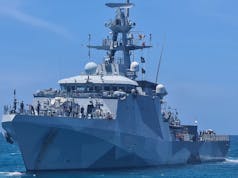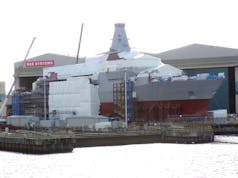The US Missile Defense Agency has confirmed the successful interception of an Intercontinental Ballistic Missile in space for the first time as part of an exercise.
The missile was fired from a warship.
According to a statement from the US Missile Defence Agency:
“The U.S. Missile Defense Agency (MDA), and U.S. Navy sailors aboard an Aegis Ballistic Missile Defense (BMD) System-equipped destroyer intercepted and destroyed a threat-representative Intercontinental Ballistic Missile (ICBM) target with a Standard Missile-3 (SM-3) Block IIA missile during a flight test demonstration in the broad ocean area northeast of Hawaii, Nov. 16. At approximately 7:50 p.m. Hawaii Standard Time, (12:50 a.m., Nov. 17, Eastern Standard Time), the ICBM-representative target was launched from the Ronald Reagan Ballistic Missile Defense Test Site, located on Kwajalein Atoll in the Republic of the Marshall Islands, toward the broad ocean area northeast of Hawaii.
In this developmental test, the destroyer used engage-on-remote capabilities through the Command and Control Battle Management Communications (C2BMC) network as part of a defense of Hawaii scenario. After receiving tracking data from the C2BMC system, the destroyer launched a SM-3 Block IIA guided missile which destroyed the target.”
“This was an incredible accomplishment and critical milestone for the Aegis BMD SM-3 Block IIA program,” said MDA Director, Vice Admiral Jon Hill.
“The Department is investigating the possibility of augmenting the Ground-based Midcourse Defense system by fielding additional sensors and weapon systems to hedge against unexpected developments in the missile threat. We have demonstrated that an Aegis BMD-equipped vessel equipped with the SM-3 Block IIA missile can defeat an ICBM-class target, which is a step in the process of determining its feasibility as part of an architecture for layered defense of the homeland. My congratulations to the entire test team, including our military and industry partners, who helped us to achieve this milestone.”
Based on preliminary data, the test met its primary objective say the agency: ‘demonstrate the ability for a SM-3 Block IIA missile to intercept an ICBM target’.













Awesome and very essential capability.
Really ought the have the Aster 30 Block 1NT on the T45s to provide similar capability
Block 1NT should be due in service next year.
With France and Italy, maybe. Not with the RN.
But now there is more money in the kitty it may not be so crazy to add some to inventory.
The think that it does depend on in Cooperative Engagement. I know Sampson is good but it won’t be a patch on a ground based station powered by the grid and. Assume cooking capabilities.
Same radar and launch systems so only really missile costs and can it be integrated into BAE CMS at a sensible price?
Block 1NT will still be behind SM3 in anti-ballistic missile capability. Same goes for the even later block 2 BMD. The true way to develop the T45’s BMD would be fitting Mk41 cells and procuring the SM3. Not to mention fitting the new Danish SMART-L-EWC Radar for an enhanced detection range against ballistic missiles.
Currently the RN is lacking in defence against even the shortest range ballistic missiles like the Chinese DF21.
This is especially pertinent as China has just announced that they concluded a recent firing test of the their DF21 and DF26 missiles, used to attack a moving target, probably a barge. To ally fears and put the test into context, the target’s position, course and speed were known prior to the launch.
It’s just a little message to their peer adversaries to let them know that whatever they can do….. The US armed forces can do equally well or better.
Actually this was a test mandated by the US Congress. The US Navy was required to show the feasibility of the SM-3 Block IIA shooting down an ICBM before the end of 2020.